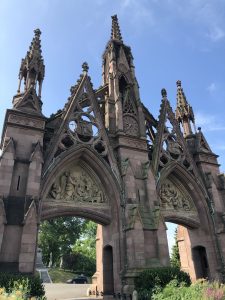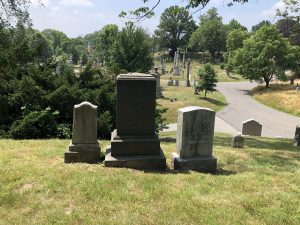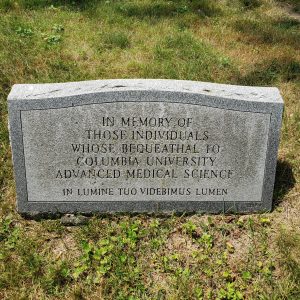A short notice in the New York Times on September 6, 1858 announces that the faculty of Columbia College, the graduating class of 1858, and friends of David Ledyard Mallison “are requested to attend his funeral, on Tuesday September 7.” Just a few months after what should have been his graduation, Columbia College held a funeral for the former student. The 20-year-old Ledyard, as he was known to his friends, was the first person buried in Columbia’s plot at Green-Wood Cemetery.

Green-Wood Cemetery was started in 1838 and its first burial took place in 1840. At the time, New Yorkers were used to being buried by their houses of worship: mostly, in small lots outside of churches. To be buried in a rural cemetery, across the river, was a tougher sell. In what may have been one of Green-Wood’s attempts to publicize their services and reach a wider audience, they offered a lot to Columbia in 1841. A few years later, in 1847, College President Nathaniel Fish Moore with the help of Janitor (and later Assistant Librarian and Proctor) Stephen R. Weeks chose lot 499 in section 56 and the College purchased the property for $1.
The lot remained unused until 1858, when the young David Ledyard Mallison of the Class of 1858 was interred. So how did he become the first occupant of the Columbia plot at Green-Wood? The Times funeral notice offers some clues. In addition to the College faculty and students, the Times includes the names of two brothers—Doctor A. (Alanson) S. Jones and Mervin N. Jones—but no parents. It also lists Mallison’s residence at No. 42 University Place, at the corner with 11th Street. According to the 1855 census, just a few years before, Mallison was living with his mother, Nancy Mallison, and his brother, Dr. Alanson S. Jones, at that address. Dr. Jones was a coroner with the Metropolitan Police Department. The 1855 census also holds a key fact. Listed at that address are also Dr. Jones’s boarders: Columbia Janitor Stephen R. Weeks, his wife Cynthia and their daughters, Frances and Theodora. Yes, the very Weeks who selected the lot in 1847 and who would have met with the young Mallison everyday on campus. (Weeks took attendance at the daily chapel service.) Thanks to Weeks, Columbia College stepped up to help Dr. Jones, who was only 35 at the time and had recently buried his own mother, to bury his younger brother.

After Mallison’s funeral, in November 1858, the Trustees formalized the arrangement. The minutes note that “interments in the ground in the Green-Wood Cemetery, belonging to the College, should, in case of the death of any of the faculty or students of the College, be allowed, under a written order from the President, or in his absence the Senior Professor present.” [1]
Weeks himself asked to be buried in the Green-Wood plot. He chose this lot over the cemetery of St. Stephen’s Church, of which he was a warden and where his wife had been buried in 1885. After Week’s more than 50 years of service to Columbia College, President Seth Low honored his final request and Weeks became the second person buried there on September 19, 1890. If you visit Columbia’s plot, you will find Mallison’s original stone right next to the one for Weeks, although his stone is a more recent replacement.

Over the years, a few other Columbians joined but, since the 1980s, the Green-Wood plot has only been used to inter the cremated remains of individuals who donated their bodies to Columbia University for the advancement of medical science.
[1] This language would remain unchanged for 90 years. It wasn’t until the summer of 1948, with Frank D. Fackenthal ending his three-year term as Acting President and with Dwight D. Eisenhower not yet sworn in as President, that the text had to be amended (and there was no longer a “Senior Professor”). In the revision, the written order authorizing burial can come from the President “or any principal administrative officer authorized to act as his representative, such as the Vice Presidents, the Provost, the Associate Provost, the Secretary, the Controller, or the Treasurer.”